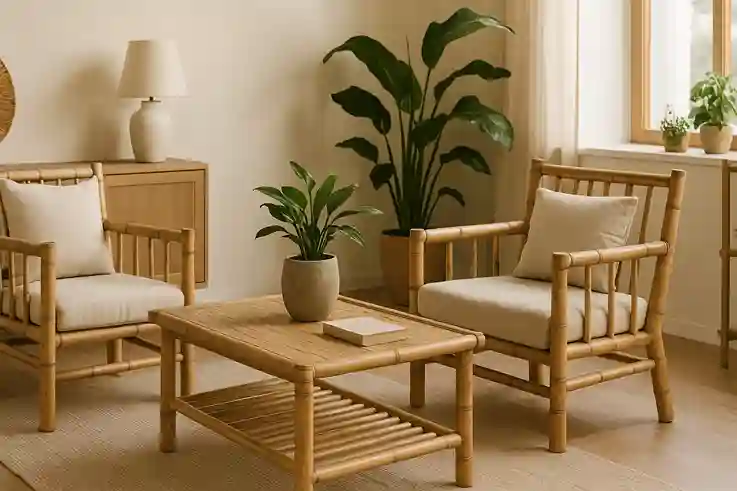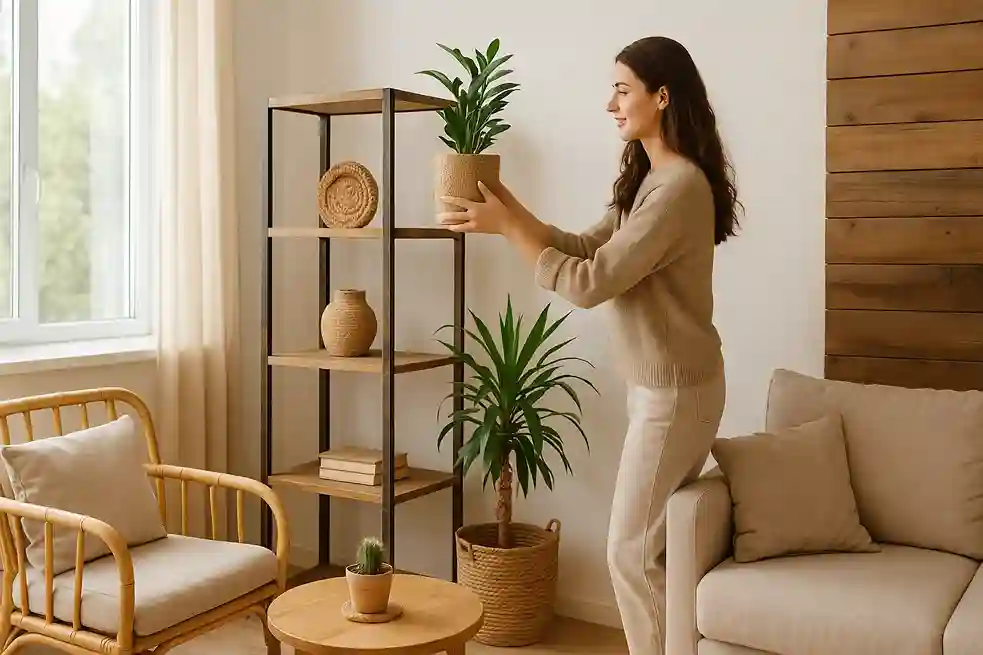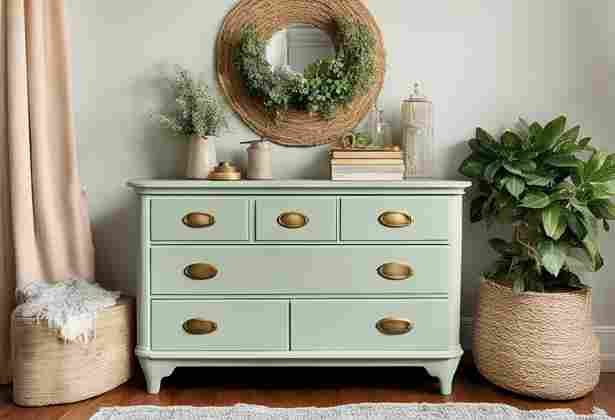Eco friendly decor is not just about how a house looks. It is about how a house feels and what it represents. Every choice we make in decorating shapes the beauty of our space and the impact on the world outside. That is why eco friendly decor matters more today than ever before.
Traditional home design often focuses only on appearance. But many materials, paints, and furnishings bring hidden costs. They can harm the environment during production and even affect indoor air quality. Eco friendly decor changes this picture. It blends design with responsibility, creating rooms that support both people and the planet.
The benefits are clear. Eco friendly decor adds beauty through natural colors and textures. It supports sustainability by using recycled, renewable, and low-impact materials. It also promotes wellness by reducing toxins and filling homes with clean air and calming energy. With every eco friendly choice, a house becomes not only more stylish but also more mindful.
What Eco Friendly Decor Really Means

Eco friendly decor means decorating in a way that respects both your home and the environment. At its core, it is about choosing materials and designs that do not harm the planet. In fact, every detail, from paint to furniture, plays a role in creating a healthier space.
To begin with, sustainable choices are key. Materials like bamboo, reclaimed wood, and cork renew quickly, so they reduce pressure on natural resources. Moreover, non-toxic paints and finishes improve indoor air, making homes safer for children and adults. In addition, recyclable products ensure less waste ends up in landfills, keeping our surroundings cleaner.
As a result, the impact is powerful. Eco friendly decor supports the planet by lowering carbon footprints and saving resources. At the same time, it supports health by limiting exposure to chemicals and pollutants. Ultimately, the result is a living space that feels calm, natural, and safe. It is design that balances style with responsibility.
Natural Materials for a Cozy Look
Wood Brings Warmth
Wood is one of the most timeless materials in eco friendly decor. Its warm tones and natural textures instantly create comfort in any room. Moreover, wood fits both modern and traditional interiors, making it a versatile choice.
In addition, reclaimed or recycled wood is especially valuable. It reduces waste, limits deforestation, and brings unique character to furniture and flooring. Each piece of reclaimed wood carries its own story, which adds charm that new materials cannot match. Ultimately, wood shows how eco friendly decor can combine beauty, durability, and responsibility in one material.
Bamboo Adds Strength

Bamboo grows incredibly fast—some species can reach maturity in just a few years—making it one of the most renewable materials available. Unlike hardwood trees that take decades to regrow, bamboo can be harvested without damaging the plant, ensuring a continuous, sustainable supply.
Its strength and versatility have made bamboo a top choice for flooring, cabinets, and wall panels. Beyond durability, bamboo brings a clean, natural look that fits beautifully into both modern and traditional spaces. Light finishes create a fresh, minimalist feel, while darker stains offer warmth and elegance. By choosing bamboo, you’re not only adding timeless style to your home but also making a conscious decision to reduce environmental impact.
Cork Creates Softness
Cork is a truly eco friendly material because it’s harvested from the bark of cork oak trees without harming the tree itself. The bark regenerates over time, allowing the same tree to be harvested again and again—making cork both gentle on nature and highly sustainable.
As a flooring material, cork offers a soft, cushioned feel that adds warmth and comfort underfoot, perfect for living areas and bedrooms. Beyond comfort, cork has natural insulating properties, helping rooms stay warmer in winter and cooler in summer, which can also reduce energy costs.
With its unique texture and earthy tones, cork complements a variety of design styles while creating a cozy, welcoming atmosphere. Choosing cork means blending comfort, beauty, and sustainability in one smart decor decision.
Stone Brings Lasting Beauty

Stone is one of the most durable and versatile natural materials, making it a favorite for eco friendly decor. Its strength allows it to last for decades, which means fewer replacements and less waste over time—a major benefit for sustainability. From countertops and fireplaces to accent walls, stone adds both texture and elegance to any space. Its natural variations in color and pattern ensure that no two pieces are exactly alike, giving your home a unique, timeless appeal.
Because it can be reused or repurposed indefinitely, stone is not only stylish but also highly sustainable. Choosing stone for your home means investing in beauty and function that will stand the test of time while minimizing environmental impact.
Mixing Textures for Style

The true charm of natural materials lies in how beautifully they complement one another. By mixing textures and finishes, you can create interiors that feel both balanced and inviting while keeping sustainability at the heart of your design. For instance, pairing warm wood with sleek stone creates a striking contrast that brings depth and sophistication to a room. Likewise, combining light bamboo with soft cork achieves a sense of harmony—balancing durability with comfort.
Blending natural elements not only enhances visual appeal but also helps design spaces that feel grounded, welcoming, and eco conscious. By thoughtfully mixing materials, you showcase the best of each one while creating a home that reflects both style and sustainability.
Natural Materials in Eco Friendly Decor
| Material | Benefits | Eco Friendly Impact |
|---|---|---|
| Wood | Warm tones, versatile, durable; reclaimed wood reduces waste and adds character | Reduces deforestation, promotes recycling, long-lasting material |
| Bamboo | Fast-growing, renewable, strong; ideal for flooring, cabinets, and wall panels | Highly renewable, lowers pressure on forests |
| Cork | Harvested without harming trees, soft, insulating, recyclable | Sustainable harvest, improves insulation, lowers energy use |
| Stone | Durable, elegant, reusable; adds texture to countertops, fireplaces, and walls | Minimizes replacement waste, natural longevity |
Recycled and Upcycled Pieces That Shine

Vintage and repurposed furniture bring a special charm to eco friendly decor. Unlike mass-produced items, these pieces often tell a story through their age, craftsmanship, and character. Moreover, they help preserve materials that might otherwise end up as waste.
For example, an old door can become a rustic dining table. A worn ladder can transform into a stylish bookshelf. Even discarded wooden crates can serve as creative storage solutions. In fact, these projects give furniture new life while keeping your home unique and personal.
At the same time, recycled and upcycled pieces save money. Instead of buying new furniture, you can reuse or refresh what you already have. This approach lowers costs while ensuring every room feels one-of-a-kind. Ultimately, recycling and upcycling prove that eco friendly decor is not only sustainable but also stylish and affordable.
Recycled and Upcycled Ideas for Eco Friendly Decor
| Item | Repurpose Idea | Eco Friendly Impact |
|---|---|---|
| Old Door | Turn into a rustic dining table | Reduces waste, adds vintage charm |
| Wooden Ladder | Convert into a bookshelf or towel rack | Extends product life, avoids landfill |
| Wooden Crates | Use as storage cubes or wall shelves | Cuts need for new storage units |
| Glass Jars | Transform into vases or light fixtures | Reduces single-use items, adds style |
| Vintage Chair | Reupholster with eco friendly fabric | Saves money, creates unique design |
Energy-Saving Decor Ideas
Energy efficiency is a key part of eco friendly decor because it lowers costs while protecting the planet. To begin with, LED lighting is one of the easiest swaps you can make. LEDs last longer, use far less energy, and come in a range of styles that fit any room. Smart fixtures add even more savings by allowing you to control brightness and schedules with ease.
Moreover, natural light is a powerful design tool. Large windows, open layouts, and strategically placed mirrors spread sunlight throughout the home. This reduces the need for artificial lighting during the day while also making spaces feel brighter and more inviting.
At the same time, efficiency does not mean sacrificing style. Modern fixtures, sleek mirror designs, and open floor plans all enhance beauty while keeping energy use low. Ultimately, these energy-saving ideas show how eco friendly decor can combine comfort, elegance, and responsibility in every corner of the home.
Different rooms call for different energy-saving ideas
In living rooms, LED floor lamps and large mirrors brighten the space while cutting power use. Bedrooms benefit from smart light switches and dimmers, which save energy and create a calm mood. Kitchens shine with task lighting that uses LEDs under cabinets, paired with open layouts that let natural light flow. Bathrooms are perfect for motion-sensor lights, ensuring energy is never wasted. Ultimately, matching the right idea to each room makes eco friendly decor both efficient and stylish.
Plants as Living Decor
Indoor plants are one of the simplest ways to bring life into eco friendly decor. They not only add greenery but also help purify the air. In fact, many common plants absorb toxins and release oxygen, making homes healthier and fresher. Moreover, plants can be easy to care for. Options like snake plants, pothos, or succulents require very little maintenance yet thrive indoors. Their resilience makes them perfect for busy households or beginners who want natural beauty without daily effort.
At the same time, plants create calm and balance in every room. Their colors and forms connect us with nature, which reduces stress and promotes well-being. Whether placed on a windowsill, hanging from the ceiling, or arranged in clusters, plants show how eco friendly decor can blend style with wellness.
Different rooms benefit from different plants. For bedrooms, calming options like lavender or peace lilies improve rest and air quality. In kitchens, herbs such as basil, mint, and rosemary grow well while also being useful for cooking. Living rooms shine with statement plants like fiddle leaf figs or snake plants, which add height and texture. Bathrooms, with higher humidity, are ideal for ferns or orchids. Ultimately, the right plant in the right room makes eco friendly decor both functional and beautiful.
Best Plants for Each Room in Eco Friendly Decor
| Room | Recommended Plants | Benefits |
|---|---|---|
| Bedroom | Peace Lily, Lavender, Snake Plant | Improves air quality, promotes relaxation and better sleep |
| Kitchen | Basil, Mint, Rosemary | Provides fresh herbs, adds greenery, easy to grow |
| Living Room | Fiddle Leaf Fig, Snake Plant, Areca Palm | Creates a focal point, adds height, cleans air |
| Bathroom | Ferns, Orchids, Aloe Vera | Thrive in humidity, add freshness, low maintenance |
Eco Friendly Fabrics and Textiles
Fabrics play a powerful role in eco friendly decor because they surround us every day. From curtains to rugs, the materials we choose shape not only style but also indoor health. In fact, textiles often hold chemicals that affect air quality, which makes eco friendly swaps especially important.
To begin with, organic cotton is a healthier alternative to conventional cotton. It avoids harmful pesticides and offers breathable comfort for cushions, throws, or bedding. Moreover, hemp is one of the most sustainable fabrics available. It is durable, requires little water, and adds natural texture to curtains or rugs. Linen, made from flax, also shines in eco friendly decor. It feels light and airy, which makes it perfect for window treatments and summer bedding.
At the same time, switching textiles is one of the easiest ways to make a home more sustainable. Choosing organic cotton curtains, hemp rugs, or linen cushion covers can instantly reduce toxins indoors. Ultimately, these simple swaps improve air quality while keeping rooms fresh, stylish, and planet-friendly.
Eco Friendly Fabrics for a Healthier Home
| Fabric | Best Use | Eco Friendly Impact |
|---|---|---|
| Organic Cotton | Curtains, cushions, bedding | Avoids harmful pesticides, breathable, safer for air quality |
| Hemp | Rugs, curtains, upholstery | Durable, needs little water, renewable, long-lasting |
| Linen | Window treatments, bedding, tablecloths | Made from flax, biodegradable, light and airy |
Different rooms benefit from different fabrics
Organic cotton is ideal for bedrooms because it keeps bedding breathable and toxin-free, supporting better sleep. Hemp works well in high-traffic spaces like living rooms, where durable rugs and sturdy curtains are needed. Linen is best for kitchens or dining areas since its light, airy texture creates a fresh, relaxed look. Ultimately, choosing the right fabric for each room makes eco friendly decor both stylish and functional.
Minimalism Meets Eco Friendly Decor
Minimalism and eco friendly decor share the same principle: less is more. By reducing clutter, you create space that feels open, calm, and intentional. At the same time, owning fewer things reduces demand for mass production, which helps protect the environment. Moreover, minimalism encourages buying fewer but better-quality pieces. Instead of filling rooms with short-lived furniture, invest in durable designs made from sustainable materials. A solid wood table or a timeless linen sofa may cost more upfront, but these pieces last longer and reduce waste over time.
Ultimately, minimalism enhances beauty by focusing on what truly matters. Clean lines, natural light, and carefully chosen textures allow each item to shine. With this approach, eco friendly decor feels not only sustainable but also elegant and timeless.
Minimalist Swaps for Eco Friendly Decor
| Old Habit | Minimalist Choice | Eco Friendly Impact |
|---|---|---|
| Filling rooms with cheap décor | Buy one durable, timeless piece | Reduces waste and long-term costs |
| Buying seasonal throwaway items | Choose versatile, year-round décor | Cuts clutter and lowers resource use |
| Stocking multiple duplicates | Keep only essentials | Saves space and limits overconsumption |
| Overfilling walls with décor | Select one statement item | Creates calm, reduces unnecessary production |
| Using synthetic, trendy fabrics | Invest in natural textiles | Improves air quality, supports sustainability |
In the end, minimalism proves that beauty does not come from more, but from better. By simplifying choices and focusing on quality, you create spaces that are sustainable, calming, and timeless. This foundation makes it easier to add other eco friendly touches, whether through energy-saving ideas, natural materials, or thoughtful textiles.
Tips to Start Small at Home
Starting with eco friendly decor does not require a complete makeover. Small steps can make a big difference when practiced consistently. Moreover, gradual changes are easier to maintain for the long term. Here are some simple ways to begin:
Swap old bulbs for LEDs – They last longer, use less energy, and instantly cut electricity costs.
Reuse what you already own – Refresh old furniture with a coat of non-toxic paint or repurpose items in creative ways.
Add indoor plants – Even one or two plants improve air quality and bring natural calm to your space.
Choose eco friendly fabrics – Start small with cushion covers or curtains made from organic cotton or linen.
Reduce clutter – Remove items you do not use and keep only meaningful, durable pieces.
Ultimately, these small changes build habits that support both the planet and your lifestyle. Over time, they transform a home into a beautiful and sustainable space.
“Simplicity is the ultimate sophistication.” – Leonardo da Vinci
Frequently Asked Questions (FAQ)
Conclusion
Eco friendly decor shows that beauty and responsibility can go hand in hand. By choosing natural materials, recycled pieces, plants, and energy-saving ideas, you create a home that feels stylish, healthy, and sustainable. Moreover, even small steps make a lasting impact when practiced consistently.
For more insights on sustainable choices for your home, check out this resource on sustainable materials in home decor.
Share your ideas in the comments — your story might inspire someone else to begin their journey toward a more beautiful and mindful home.

Amber Hexshot is a creative blogger with a specialty in home décor, where she shares fresh ideas on design, styling, and creating inviting spaces. With a keen eye for detail and a love for transforming everyday rooms into inspiring environments, she enjoys helping readers bring beauty and personality into their homes. Beyond décor, Amber also explores other topics such as lifestyle, travel, and personal growth, offering a wide variety of content that resonates with her audience.
When she’s not writing, Amber loves visiting art galleries, experimenting with DIY projects, and discovering unique design trends from around the world. Her approachable tone and practical advice make her blogs both inspiring and easy to follow.


